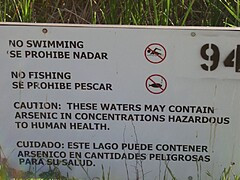|
The information on this page is adapted from toxipedia.org. To learn more about Toxipedia’s integration into our website, visit our Toxipedia webpage. |
Arsenic is a naturally occuring chemical with several common uses and a range of health impacts. Arsenic poisoning from well water remains a serious worldwide human health concern.
People long ago recognized that depending on the dose, arsenic could either treat an illness or be used as a poison to cause death. Its medicinal use to treat syphilis and amebic dysentery ended with the introduction of penicillin and other antibiotics in the twentieth century. Arsenic-based compounds are currently used to treat some forms of cancer. As a poison, arsenic trioxide (As2O3) has several desirable qualities: it looks like sugar and is tasteless, and only a fraction of a gram can kill an adult.
Production and Uses
Though arsenic occurs naturally in rocks and soil, the majority of arsenic released into the environment is from industrial smelting, produced as byproduct of smelting for copper, lead and zinc. The last US smelter producing arsenic closed in 1985 in Tacoma, Washington. Smelters typically released the trivalent arsenic trioxide and lead into the atmosphere, which contaminated local environments and left an unhealthful legacy for local residents. Inorganic arsenic is also released from coal-fired electric generation facilities.
Since US production ceased in 1985, all arsenic consumed in the United States is imported. Imports of arsenic (metal and compounds combined) have increased substantially since the mid-1980s, reaching 8,810 metric tons (as arsenic content) in 2005, of which 812 metric tons was as elemental arsenic. In 2005, 11,000 metric tons of arsenic trioxide was imported into the United States.1
Wood Preservative
The major use of inorganic arsenic has been in wood preservation, although its use for residential wood preservation has been phased out.2
Pesticide
Inorganic arsenic had been used as a pesticide in cotton fields and orchards, although that use was voluntarily canceled in the late 1980s and the early 1990s.3 Some forms of organic arsenic continue to be applied to cotton fields. Organic arsenic compounds are also used as a feed additive to enhance growth of poultry and swine.
Other Uses
Arsenic is also used in the manufacture of silicon-based computer chip technology4 and in glass manufacture.5 Elemental arsenic is used as an alloying element in ammunition and solders, as an antifriction additive to metals used for bearings, and to strengthen lead-acid storage battery grids.6
Chemical and Biological Properties
|
image from fdecomite at Creative Commons, modified |
Arsenic is a versatile metal, forming various compounds, either inorganic or organic. Inorganic arsenic is widely distributed in nature, usually in the trivalent form (As3+) but also as pentavalent arsenic (As5+). Most rocks contain one to five parts per million (ppm) of arsenic. The trivalent forms include arsenic trioxide, sodium arsenite and arsenic trichloride. Organic arsenic, much less toxic than inorganic arsenic, is produced in a biomethylation process by many organisms including humans and shellfish.
Organic arsenic compounds found in seafood are not well absorbed, but soluble inorganic arsenic compounds, such as arsenic trioxide, are readily absorbed from the intestine (80-90%). Arsenic can also be absorbed through the lungs and skin. Most of the arsenic in the blood is bound to red blood cells.
Metabolism of Arsenic
Once ingested, inorganic arsenic is biotransformed by the liver to a methylated form of arsenic and excreted in the urine with a half-life of three to five days. Arsenic is also excreted in the outer layer of skin cells and in sweat. Arsenic binds to sulfhydryl-containing proteins and concentrates in the hair and fingernails.
Health Effects
Acute Exposure
Ingestion of 70 to 180 mg of arsenic trioxide can be fatal, but initial effects may be delayed for several hours. Acute oral ingestion of lower doses can result in these symptoms:7
-
Irritation of your stomach and intestines, with symptoms such as stomachache, nausea, vomiting, and diarrhea.
image from Brick Red at Creative Commons
- Decreased production of red and white blood cells, which may cause fatigue, abnormal heart rhythm, blood-vessel damage resulting in bruising, and impaired nerve function causing a "pins and needles" sensation in your hands and feet.
- White bands, called Mees' lines, are visible in the nails.8
Chronic Exposure
Arsenic poisoning or arsenicosis is most often associated with drinking water contaminated with arsenic. Signs and possible impacts of arsenic exposure:9
- Skin changes including patches of darkened skin and the appearance of small "corns" or "warts" on the palms, soles, and torso; these are often associated with changes in the blood vessels of the skin.
- Skin cancer
- Cancer of the liver, bladder, kidney or lungs
- Possibly diabetes, high blood pressure, reproductive disorders and lower IQ scores
Inhaling high levels of inorganic arsenic is associated with these signs and symptoms:10
- Sore throat and irritated lungs
- Skin effects described above
- Circulatory and peripheral nervous disorders
Direct skin contact with high concentrations of inorganic arsenic compounds may cause the skin to become irritated, with some redness and swelling. However, it does not appear that skin contact is likely to lead to any serious internal effects.11
Much less is known about the health effects of organic arsenic. In animals, ingestion of methyl compounds can result in diarrhea, and lifetime exposure can damage the kidneys. Lifetime exposure to dimethyl compounds can damage the urinary bladder and the kidneys.12
Cancer Classification
These entities have classified arsenic as a cause of cancer:13
- The International Agency for Research on Cancer (IARC): inorganic arsenic is carcinogenic to humans.
- The US Department of Health and Human Services (DHHS): inorganic arsenic is known to be a human carcinogen
- US EPA: arsenic is a known human carcinogen.
Vulnerable Populations
Children have higher levels of exposure, particularly if drinking water concentrations of arsenic are elevated, because of their smaller size and greater consumption of water relative to their size. Children also play in soil, put their hands in their mouths and intentionally eat soil more often than adults do on average.14 Exposures in childhood also afford many more years for long-latency diseases and disorders (such as cancer) to develop than adult exposures.
Adults who work in industries that involve arsenic production or use (copper or lead smelting, wood treating, or pesticide application, among others) could be exposed to elevated levels of arsenic at work. Those who saw CCA-treated wood, plus all people who live near or frequent some mining and smelting sites or agricultural areas where arsenic pesticides had been applied in the past may be exposed to much higher levels of arsenic than others.15
Exposure
The lethal dose of arsenic in humans is 2-20 mg/kg, or 140 to 1400 mg for an average-sized adult. A 140-mg potentially lethal dose is the same as 0.145 grams. Less than 1/8 teaspoon can be fatal to a healthy adult, while even less could kill a child, an adult with impaired health, or an elderly person.16
Background Exposures
Most people are exposed to constant but low levels of arsenic. Normally, background air levels are less than 0.1 μg/m3 and drinking water less than 5 μg/L, but water levels can be significantly higher. The total average daily exposure to arsenic is about 20 μg/day from food and water (assuming 2000 mL/day average water consumption at 5 μg/L arsenic), but this can vary significantly depending on diet and water source.
Food Exposure
Arsenic may be present in grains, fruits, vegetables and other foods. Arsenic exposure from ingested foods usually comes from food crops grown in arsenic-contaminated soil and/or irrigated with arsenic-contaminated water.17 Most crops don’t readily take up much arsenic from the ground, but rice is an exception—it takes up arsenic from soil and water more readily than other grains. In addition, some seafood has high levels of less toxic organic arsenic.18 Food usually supplies less than 10 μg/day of arsenic but can be higher with the consumption of rice and fish, and particularly shellfish, which can have arsenic levels up to 30 μg/g.
The US Food and Drug Administration (FDA) has been monitoring the levels of arsenic in foods for decades and increased its testing in 2011. Arsenic levels in apples have been raised as a concern, but FDA's results have confirmed that the amount of arsenic in apple juice is low.19
Water Exposure
Arsenic poisoning from well water remains a serious worldwide human health concern. Tens of millions of people in Bangladesh are estimated to have been exposed to arsenic-contaminated water,20 resulting in an estimated 24,000 deaths each year.21 People in Argentina, Chile and Taiwan also have elevated arsenic in their drinking water.22 This is also relevant to areas of the western United States that have elevated levels of arsenic in drinking water. High levels of arsenic in local soil or rock contaminate the local water supply.
In the United States, the federal government struggled for years to establish standards of arsenic in drinking water. On January 22, 2001, EPA adopted a new standard for arsenic in drinking water of 0.01 mg/l, or 10 parts per billion (ppb), replacing the old standard of 50 ppb.23
Pressure-treated Wood
|
image from ntm1909 at Creative Commons |
Wood treated with the pesticide chromated copper arsenate (CCA) was first used in the 1940s. CCA is a water-based mixture of inorganic salts of chromium, copper and arsenic that is forced into wood under pressure. Arsenic can transfer to hands by direct contact. Children who play on decks or other treated surfaces pick up small amounts of arsenic on their hands, from which it can be transferred to food or directly from hands into children's mouths. The potential exposure that children may receive from playing in play structures constructed from CCA-treated wood is generally smaller than that they would receive from food and water.24
The amount of arsenic in treated wood can be quite large. A standard eight-foot length of treated 2" x 4" lumber contains as much as 15 grams of arsenic. Inhaling sawdust from construction with treated lumber is known to be dangerous.25 Arsenic leaches from the wood with rainfall, and contamination of soil under decks may exceed hazardous waste cleanup standards.26
Wood treated with CCA is still found in decks, playground equipment, outdoor furniture, fences, construction lumber, utility poles, piers, and pilings. In December 2003, chromated arsenicals manufacturers voluntarily discontinued manufacturing chromated arsenicals-treated wood products for homeowner uses. However, EPA has not banned chromated arsenicals and does not require the removal of existing structures made with wood treated with chromated arsenicals or the surrounding soil.27
There are a number of arsenic-free wood preservatives on the market that are registered for use in treated wood for residential use. CCA will still be available for commercial uses such as utility poles. The alternative wood treatment most used to replace CCA is a copper-based preservative called ammoniacal copper quaternary, or ACQ. ACQ has a much lower toxicity to humans than CCA.28
Tobacco
Cigarettes contain small amounts of arsenic, and smokers inhale some arsenic in tobacco smoke.29
Reducing Exposure
- Avoid inhalation of sawdust from arsenic-treated lumber, and never burn any treated lumber or sawdust.
- If you have an older deck or other structure made with chromated arsenicals-treated wood, applying a penetrating protective coating (such as oil- or water-based stains) on a regular basis may reduce the leaching of chemicals.30
- Testing the soil underneath decks and other structures made with treated wood will indicate whether remediation of soil is needed.
- Wear gloves and other protective clothing when working with treated lumber or contaminated soil.
- Wash your hands after coming in contact with any arsenic-treated product, and supervise children in washing their hands promptly after contact.
- Test well water for arsenic, and if needed, either use bottled water for drinking and cooking or use a filter that removes arsenic.31
- Take care to reduce arsenic exposure from rice, especially for children or if you consume more rice than average. In 2014 Consumer Reports investigated which varieties of rice have higher levels, cooking methods that reduce arsenic levels, and alternate grains that are naturally lower in arsenic.32
Regulatory Standards
- World Health Organization: provisional drinking water guideline of 10 ppb33
- US EPA: Drinking water 10 μg/L (10 ppb)34
- OSHA: no greater than 10 micrograms of inorganic arsenic per cubic meter of air, averaged over any eight-hour period for a 40-hour workweek35
- EPA Reference Dose (RfD) for inorganic arsenic is 0.3 μg/kg/day, based on hyperpigmentation, keratosis, and possible vascular complications in humans. The RfD is an estimate that is likely to be without appreciable risk of deleterious noncancer effects during a lifetime.36
Brief History
Arsenic has a long and diverse history of use. It was favored as a poison from Roman times to the mid nineteenth century due to its lack of color, odor and flavor. Arsenic poisoning was such a widespread concern that the Roman Consul Lucius Cornelius Sulla issued the Lex Cornelia in 82 BC outlawing arsenic poisoning. The use of arsenic as a poison began decreasing in the 18th century, when English chemist James Marsh developed a chemical test that identifies arsenic in the body.
Two tests for arsenic are available today. The first test measures the total amount of arsenic in the body, making no distinction between the harmful inorganic forms and the harmless organic form. The second test measures only the inorganic arsenic that has passed through the body, and is a better indicator of overall health. Tests that measure arsenic levels in hair and fingernail samples are also available; these may help evaluate long-term arsenic exposure but are not widely used because of problems with accuracy.
The use of arsenic as a pesticide began in the late nineteenth century. Though the majority of arsenic-based pesticides are no longer used in agriculture or horticulture in the US, arsenic-based wood preservatives are still used in nonresidential construction.
See more about arsenic and health in the list of CHE publications and Dig Deeper resources in the right sidebar.
This information was written by Dr. Steven Gilbert of Toxipedia and updated by Nancy Hepp in August 2016.
CHE invites our partners to submit corrections and clarifications to this page. Please include links to research to support your submissions through the comment form on our Contact page.
* header image from Rui Costa at Creative Commons



